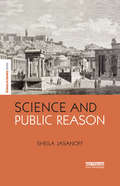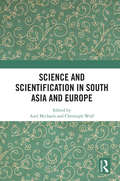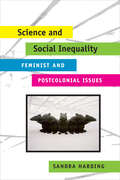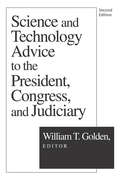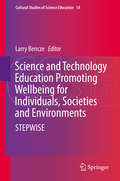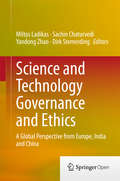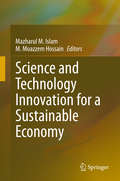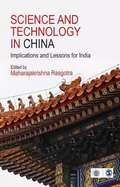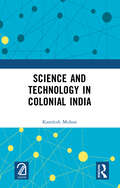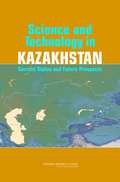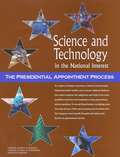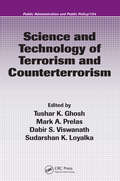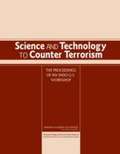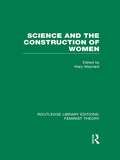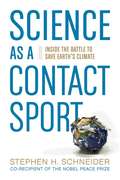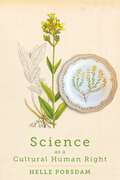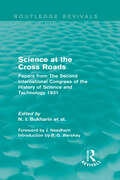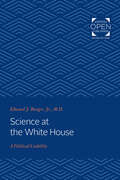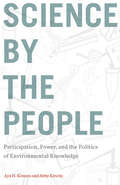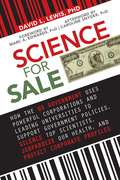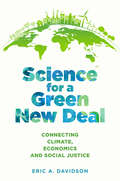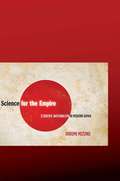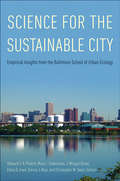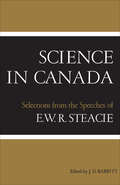- Table View
- List View
Science and Public Reason (The Earthscan Science in Society Series)
by Sheila JasanoffThis collection of essays by Sheila Jasanoff explores how democratic governments construct public reason, that is, the forms of evidence and argument used in making state decisions accountable to citizens. The term public reason as used here is not simply a matter of deploying principled arguments that respect the norms of democratic deliberation. Jasanoff investigates what states do in practice when they claim to be reasoning in the public interest. Reason, from this perspective, comprises the institutional practices, discourses, techniques and instruments through which governments claim legitimacy in an era of potentially unbounded risks—physical, political, and moral. Those legitimating efforts, in turn, depend on citizens’ acceptance of the forms of reasoning that governments offer. Included here therefore is an inquiry into the conditions that lead citizens of democratic societies to accept policy justification as being reasonable. These modes of public knowing, or “civic epistemologies,” are integral to the constitution of contemporary political cultures. Methodologically, the book is grounded in the field of Science and Technology Studies (STS). It uses in-depth qualitative studies of legal and political practices to shed light on divergent cross-cultural constructions of public reason and the reasoning political subject. The collection as a whole contributes to democratic theory, legal studies, comparative politics, geography, and ethnographies of modernity, as well as STS.
Science and Risk Regulation in International Law
by Jacqueline PeelThe regulation of risk is a preoccupation of contemporary global society and an increasingly important part of international law in areas ranging from environmental protection to international trade. This book examines a key aspect of international risk regulation - the way in which science and technical expertise are used in reaching decisions about how to assess and manage global risks. An interdisciplinary analysis is employed to illuminate how science has been used in international legal processes and global institutions such as the World Trade Organization. Case studies of risk regulation in international law are drawn from diverse fields including environmental treaty law, international trade law, food safety regulation and standard-setting, biosafety and chemicals regulation. The book also addresses the important question of the most appropriate balance between science and non-scientific inputs in different areas of international risk regulation.
Science and Scientification in South Asia and Europe
by Christoph Wulf Axel MichaelsThis volume critically examines the role of science in the humanities and social sciences. It studies how cultures and societies in South Asia and Europe underwent a transformation with the adoption or adaptation of scientific methods, turning ancient cultural processes and phenomena into an enhanced scientific structure. The chapters in this book Discuss the development of science as a method in modern and historical contexts and the differences between modern science, scientification and pseudoscience. Study the interactions between bodies of knowledge such as Sanskrit and computer science; mathematics and Vedic mathematics; science and philosophy. Drawing on textual material, extensive fieldwork and in-depth interviews, this book will be of great interest to scholars and researchers of philosophy, Indology, history, linguistics, history and philosophy of science and social science.
Science and Social Inequality: Feminist and Postcolonial Issues (Race and Gender in Science Ser.)
by Sandra HardingHarding argues that the philosophy and practices of today's Western science, contrary to its enlightenment mission, actually work to insure that more science will only worsen existing gaps between the best and worst of societies around the world.
Science and Technology Advice: To the President, Congress and Judiciary
by William T. GoldenThis volume aims to attract attention to the necessity for quality advice on science and technology issues to the president of the United States, to the Congress, and to the judiciary. It emphasizes reconsideration and improvement of existing organizations and mechanisms, mindful of the need to adapt to changing circumstances. Golden has gathered facts and opinions useful to a wide range of people: government officials and staffs in all three branches; journalists; scholars and students of political science, science policy, and the history of science policy; members of the industrial and financial communities; and the concerned citizenry. The eighty-five prominent experts include both of President Reagan's science advisors, President Gerald R. Ford, congressional leaders, and distinguished members of the judiciary.
Science and Technology Education Promoting Wellbeing for Individuals, Societies and Environments
by Larry BenczeThis edited volume provides theoretical and practical resources relating to the 'STEPWISE' curricular and instructional framework. 'STEPWISE' is the acronym for Science & Technology Education Promoting Wellbeing for Individuals, Societies & Environments. It is a framework for organizing teaching and learning domains in ways that prioritize personal and social actions to address 'critical socioscientific issues' -- that is, controversial decisions by powerful individuals/groups about science and technology (and related fields) that may adversely affect individuals, societies and/or environments. The book contains chapters written by and/or with teachers who have used STEPWISE to guide their instructional practices, as well as chapters written by education scholars who have used a range of theoretical lenses to analyze and evaluate STEPWISE -- and, in several cases, described ways in which it relates to (or could relate to) their practices and/or ways in which the framework might logically be amended. Overall, this book offers educators, policy makers and others with resources useful for arranging science and technology education in ways that may assist societies in addressing significant potential personal, social and/or environmental problems -- such as dramatic climate change, preventable human diseases, species losses, and social injustices -- associated with fields of science and technology.
Science and Technology Governance and Ethics
by Miltos Ladikas Sachin Chaturvedi Yandong Zhao Dirk StemerdingThis book analyzes the possibilities for effective global governance of science in Europe, India and China. Authors from the three regions join forces to explore how ethical concerns over new technologies can be incorporated into global science and technology policies. The first chapter introduces the topic, offering a global perspective on embedding ethics in science and technology policy. Chapter Two compares the institutionalization of ethical debates in science, technology and innovation policy in three important regions: Europe, India and China. The third chapter explores public perceptions of science and technology in these same three regions. Chapter Four discusses public engagement in the governance of science and technology, and Chapter Five reviews science and technology governance and European values. The sixth chapter describes and analyzes values demonstrated in the constitution of the People's Republic of China. Chapter Seven describes emerging evidence from India on the uses of science and technology for socio-economic development, and the quest for inclusive growth. In Chapter Eight, the authors propose a comparative framework for studying global ethics in science and technology. The following three chapters offer case studies and analysis of three emerging industries in India, China and Europe: new food technologies, nanotechnology and synthetic biology. Chapter 12 gathers all these threads for a comprehensive discussion on incorporating ethics into science and technology policy. The analysis is undertaken against the backdrop of different value systems and varying levels of public perception of risks and benefits. The book introduces a common analytical framework for the comparative discussion of ethics at the international level. The authors offer policy recommendations for effective collaboration among the three regions, to promote responsible governance in science and technology and a common analytical perspective in ethics.
Science and Technology Innovation for a Sustainable Economy
by Mazharul M. Islam M. Moazzem HossainThis book discusses the subject of pathways to a sustainable economy through science and technology innovations which are regarded as the important components of the ‘4th Industrial Revolution’. The volume has been developed from Bangladesh’s ‘Vision 2041’ agenda which includes development actions needed to catch up with more developed nations. Most importantly, the goals of the ‘Vision 2041’ have been taken from the dreams of the architect of independent Bangladesh, Bangabandhu (Friends of Bengal) Sheikh Mujibur Rahman. His dream was to make Bangladesh the Switzerland of Asia. The Father of Bangladesh Nation was killed by assassins’ bullets along with his most of the family members in August 1975. After his death, the nation moved backwards while recovering from nine months of liberation post war in 1971.Between 1975 and 1990 Bangladesh was ruled by military and quasi military governments. Bangladesh established a true democratic regime in 1996 with Sheikh Mujib’s daughter, Sheikh Hasina, who formed the government after 21 years with a mandate to realise the dreams of her father. Sheikh Hasina, had her own 20 year vision for Bangladesh, called, ‘Vision 2021’, with plans to make the nation poverty free by 2021. After a pause between 2001 and 2008, Sheikh Hasina returned to power in 2009. Under her consecutive three terms she brought Bangladesh back on track and Bangladesh is one of the nations which reduced poverty half under MDGs by 2015. During her third consecutive term Sheikh Hasina, is on the way to transforming Bangladesh into a ‘middle income’ nation by 2021. This volume aims to identify and mitigate the challenges of ‘4th Industrial Revolution’ investigating the areas of science and technology innovations for Bangladesh and for other parts of the world keeping in mind establishing a sustainable economy under UN agendas to 2030 (SDGs). The primary audience for this book are UN development agencies, academic institutions, government policymakers and business leaders of the more developed and developing nations alike.
Science and Technology in China
by Maharajakrishna RasgotraScience and Technology in China discusses the changing structural and institutional context of scientific research in China. The new environment of global competition entails that the norms of generation of new knowledge are as important as those for innovation and commercialization. China has been able to achieve this in a largely state-controlled environment, where political will and commitments have played an increasingly important role. India, on the other hand, is still caught in a paradox of too much democracy at all levels of social and economic activity. It needs a big political push and inclusive decentralized approach to realize its well-defined plans and objectives to make its international presence felt. The essays focus on China's nuclear programme, space technology, aviation, aeronautics, IT and industrial development. The contributors conclude that India has to carefully tailor its own military strategy and diplomacy in the Asian region to greater effect with better harnessing and utilization of its strengths in science and technology. The reforms, policy initiatives and strategies in multiple sectors initiated by China contain crucial lessons and one key message for India--the need to pursue a coordinated and single-minded strategy to achieve its goals.
Science and Technology in Colonial India
by Kamlesh MohanThis book is a significant contribution to the socio-political history of science and technology in India, combining a wholistic perspective with a strong regional flavour. It revolves around two basic issues. First is the role of science and technology in empire-building in Asia, specifically in India, and financing its maintenance through maximum exploitation of its human, natural, agricultural and other resources by launching and executing a number of exploratory projects, termed as ‘field sciences’. Such an imperial focus was undergirded by a crucial objective; the acquisition of hegemony through social control based on intimate knowledge of horizontal and vertical divisions in lndian society around the axes of religion and caste. Formalised as colonial ethnography by the administrators, it was institutionalised as a discipline in the British universities. Second concerns the decoding of the complex response of the Indian intelligentsia including the English-educated as well as the experts and advocates of classical and regional languages which were the key to indigenous knowledge in indigenous sciences, arts and literature.The book also discusses the innovative use of print technology by Arya Samaj in recasting Hindu consciousness and its alternative of seeking historical guidelines in the past.
Science and Technology in KAZAKHSTAN: Current Status and Future Prospects
by National Research Council of the National AcademiesKazakhstan has an ambitious program to increase its technological competitiveness in the global market place during the next few years, but achieving success will depend in large measure on the effectiveness of upgraded science and technology (S&T) capabilities. This report identifies important opportunities and limitations in the education system, research and development (R&D) institutions, production companies, and service organizations to help governmental organizations in Kazakhstan with strong interests in S&T chart the future course of the country.
Science and Technology in the National Interest: The Presidential Appointment Process
by Institute of MedicineThis report is the second edition of the 1992 COSEPUP report "Science and Technology Leadership in American Government: Ensuring the Best Presidential Appointments." As was the case with the original report, this report analyzes the federal government's capacity to recruit highly qualified individuals for the top science and technology (S&T)-related leadership positions in the executive branch and makes appropriate recommendations.
Science and Technology of Terrorism and Counterterrorism (Public Administration and Public Policy)
by Thomas M. HaladynaTraditionally, resources on terrorism and counterterrorism tend to focus on the social, behavioral, and legal aspects of the subject, with minimal emphasis on the scientific and technological aspects. Taking into account these practical considerations, the second edition of Science and Technology of Terrorism and Counterterrorism discusses the natu
Science and Technology to Counter Terrorism: Proceedings of an Indo-U.S. Workshop
by National Academy of Sciences of the National AcademiesThis volume presents the papers and summarizes the discussions of a workshop held in Goa, India, in January 2004, organized by the Indian National Institute of Advanced Science (NIAS) and the U.S. Committee on International Security and Arms Control (CISAC). During the workshop, Indian and U.S. experts examined the terrorist threat faced in both countries and elsewhere in the world, and explored opportunities for the U.S. and India to work together. Bringing together scientists and experts with common scientific and technical backgrounds from different cultures provided a unique opportunity to explore possible means of preventing or mitigating future terrorist attacks.
Science and the Construction of Women: Feminist Theory: Science And The Construction Of Women (rle Feminist Theory) (Routledge Library Editions: Feminist Theory)
by Mary MaynardScience and the Construction of Women is a multi-disciplinary exploration of the major questions currently challenging feminist scholars of science. The authors ask key questions: What constitutes science? How have feminists investigated it? How does science ‘construct’ women? How can we create a feminist discourse of science? Are the current developments to women’s advantage or disadvantage? Their answers draw on material from a wide range of natural scientific, humanities and social science sources, critically examining theoretical approaches from the postmodern to the materialist to the cyborgian. A key argument of the book is that there are strong intellectual and pragmatic reasons – the rapid development of information technology, advances in fertility treatment and genetic engineering, feminist concern for environmental issues – why feminism must rigorously engage with issues of a scientific and technological nature. Science and the Construction of Women provides an important contribution to the opening-up and broadening of debate in the field. This book will be an important text for students of gender and women’s studies, and science studies. It is also designed to be read by feminists both inside and outside the academy and to appeal to all those with interests in the sociology of knowledge and the history of ideas.
Science as a Contact Sport: Inside the Battle to Save Earth's Climate
by Stephen H. SchneiderA member of the Intergovernmental Panel on Climate Change that won the 2007 Nobel Peace Prize, Schneider (interdisciplinary environmental studies and biology, Stanford U.) draws on his own participation and other sources to trace the campaign to recognize and address climate change over the past four decades. His topics include smoke on the horizon, a fragile planet grows alarmed, the battle heats up and so does the world, the stories behind persistent distortion in the media, and what should keep people awake at night. Annotation ©2010 Book News, Inc., Portland, OR (booknews.com)
Science as a Cultural Human Right (Pennsylvania Studies in Human Rights)
by Helle PorsdamThe human right to science, outlined in the 1948 Universal Declaration of Human Rights and repeated in the 1966 International Covenant on Economic, Social, and Cultural Rights, recognizes everyone’s right to “share in scientific advancement and its benefits” and to “enjoy the benefits of scientific progress and its applications.” This right also requires state parties to develop and disseminate science, to respect the freedom of scientific research, and to recognize the benefits of international contacts and co-operation in the scientific field.The right to science has never been more important. Even before the COVID-19 health crisis, it was evident that people around the world increasingly rely on science and technology in almost every sphere of their lives from the development of medicines and the treatment of diseases, to transport, agriculture, and the facilitation of global communication. At the same time, however, the value of science has been under attack, with some raising alarm at the emergence of “post-truth” societies. “Dual use” and unintended, because often unforeseen, consequences of emerging technologies are also perceived to be a serious risk.The important role played by science and technology and the potential for dual use makes it imperative to evaluate scientific research and its products not only on their scientific but also on their human rights merits. In Science as a Cultural Human Right, Helle Porsdam argues robustly for the role of the right to science now and in the future. The book analyzes the legal stature of this right, the potential consequences of not establishing it as fundamental, and its connection to global cultural rights. It offers the basis for defending the free and responsible practice of science and ensuring that its benefits are spread globally.
Science at the Cross Roads: Papers from The Second International Congress of the History of Science and Technology 1931 (Routledge Revivals)
by N. I. Bukharin et alThe papers given by the Soviet Delegation to the Second International Congress of the History of Science and Technology in London in 1931, headed by N. I. Bukharin, exerted a profound influence on Western historiography of science. Perhaps the most influential contribution was that of Hessen, who made a long and classical statement of Marxist historiography, taking Isaac Newton as his example. The collection, which appeared in Britain at the height of the Depression, fostered an acute social awareness and a heated debate among many working scientists. Accredited by some as "the starting point of a new evaluation of the history of science", the book reflects the huge social and economic divide between Socialism and Capitalism present at the time of publication, and its influence on intellectual culture and scientific advancement.
Science at the White House: A Political Liability
by Edward J. Burger Jr.Originally published in 1980. In 1973 the US president's Office of Science and Technology was eliminated, a victim of its own incongruity. It was not, as was popularly proclaimed at the time, simply because the Nixon administration was particularly hostile to the scientific and academic communities. It was eliminated, argues physician-scientist Edward J. Burger Jr., because the office had tried to do its job too well—and had become a political liability. Science at the White House takes a critical look at the role of science advisers to the president and recounts the many conflicts that occurred as science and politics converged. Burger draws on his own six years of experience in the White House Office of Science and Technology in the 1970s. His book is filled with firsthand descriptions of the government's handling of such issues as national health care, environmental regulation, population control, and biomedical research.
Science by the People: Participation, Power, and the Politics of Environmental Knowledge (Nature, Society, and Culture)
by Aya H. Kimura Abby KinchyCitizen science—research involving nonprofessionals in the research process—has attracted both strong enthusiasts and detractors. Many environmental professionals, activists, and scholars consider citizen science part of their toolkit for addressing environmental challenges. Critics, however, contend that it represents a corporate takeover of scientific priorities. In this timely book, two sociologists move beyond this binary debate by analyzing the tensions and dilemmas that citizen science projects commonly face. Key lessons are drawn from case studies where citizen scientists have investigated the impact of shale oil and gas, nuclear power, and genetically engineered crops. These studies show that diverse citizen science projects face shared dilemmas relating to austerity pressures, presumed boundaries between science and activism, and difficulties moving between scales of environmental problems. By unpacking the politics of citizen science, this book aims to help people negotiate a complex political landscape and choose paths moving toward social change and environmental sustainability.
Science for Sale: How the US Government Uses Powerful Corporations and Leading Universities to Support Government Policies, Silence Top Scientists, Jeopardize Our Health, and Protect Corporate Profits
by David L. LewisFor the first time in paperback and with a new introduction. Discover how and why the government is corrupting scientific research.When Speaker Newt Gingrich greeted Dr. David Lewis in his office overlooking the National Mall, he looked at Dr. Lewis and said: "You know you’re going to be fired for this, don’t you?” "I know,” Dr. Lewis replied, "I just hope to stay out of prison.” Gingrich had just read Dr. Lewis’s commentary in Nature, titled "EPA Science: Casualty of Election Politics.” Three years later, and thirty years after Dr. Lewis began working at EPA, he was back in Washington to receive a Science Achievement Award from Administrator Carol Browner for his second article in Nature. By then, EPA had transferred Dr. Lewis to the University of Georgia to await termination—the Agency’s only scientist to ever be lead author on papers published in Nature and Lancet.The government hires scientists to support its policies; industry hires them to support its business; and universities hire them to bring in grants that are handed out to support government policies and industry practices. Organizations dealing with scientific integrity are designed only to weed out those who commit fraud behind the backs of the institutions where they work. The greatest threat of all is the purposeful corruption of the scientific enterprise by the institutions themselves. The science they create is often only an illusion, designed to deceive; and the scientists they destroy to protect that illusion are often our best. This book is about both, beginning with Dr. Lewis’s experience, and ending with the story of Dr. Andrew Wakefield. This new edition, now for the first time in paperback, features a new introduction by the author.
Science for a Green New Deal: Connecting Climate, Economics, and Social Justice
by Eric A. DavidsonScience, not politics, can take us beyond the hype and headlines to forge a realistic green new deal.Since it was first proposed in the US House of Representatives, the Green New Deal has been hotly debated, often using partisan characterizations that critique it as extreme or socialist. The intent was not simply to fight climate change or address a specific environmental concern, but rather to tackle how climate change and other environmental challenges affect the economy, the vulnerable, and social justice—and vice versa. In Science for a Green New Deal, Eric Davidson dissects this legislative resolution. He also shows how green new deal thinking offers a framework for a much-needed convergence of the natural sciences, social science, economics, and community engagement to develop holistic policy solutions to the most pressing issues of our day. Davidson weaves the case for linkages among multiple global crises, including a pandemic that has reversed progress on fighting poverty and hunger, an acceleration of climate change that has exacerbated storms, floods, droughts, and fires, and a renewed awareness of profound social injustices highlighted by the Black Lives Matter movement.Illustrating these points with his personal life experiences as a child growing up in Montana and as a famed researcher leading a large scientific society, Davidson relates these complex challenges to our everyday lives and decision-making. How, he asks, can we extract from the Earth's resources what we need for the prosperity, well-being, and dignity of current and future generations of billions of people without exhausting or polluting those resources? Written in clear, jargon-free prose, Science for a Green New Deal is a realistic and optimistic look at how we can attain a more sustainable, prosperous, and just future.
Science for the Empire
by Hiromi MizunoMizuno (history, U. of Minnesota) explores the relationship between discourses of science, nationalism, and modernity in Imperial Japan, particularly focusing on competing promotions of science amongst Japanese technology-bureaucrats, Marxist intellectuals, and popular science writers engaged in the developing the new genre of popular science (tsuzoku kagagku) journalism and how those competing visions were eventually co-opted and mobilized by the Imperial state in support of wartime objectives. Annotation ©2009 Book News, Inc. , Portland, OR (booknews. com)
Science for the Sustainable City: Empirical Insights from the Baltimore School of Urban Ecology
by J. Morgan Grove Mary L. Cadenasso Steward T. A. Pickett Elena G. Irwin Emma J. Rosi Christopher M. SwanA presentation of key findings and insights from over two decades of research, education, and community engagement in the acclaimed Baltimore Ecosystem Study In a world of more than seven billion people—who mostly reside in cities and towns—the Baltimore Ecosystem Study is recognized as a pioneer in modern urban social-ecological science. After two decades of research, education, and community engagement, there are insights to share, generalizations to examine, and research needs to highlight. This timely volume synthesizes the key findings, melds the perspectives of different disciplines, and celebrates the benefits of interacting with diverse communities and institutions in improving Baltimore’s ecology. These widely applicable insights from Baltimore contribute to our understanding the ecology of other cities, provide a comparison for the global process of urbanization, and inform establishment of urban ecological research elsewhere. Comprehensive, interdisciplinary, and highly original, it gives voice to the wide array of specialists who have contributed to this living urban laboratory.
Science in Canada: Selections from the Speeches of E.W.R. Steacie
by J. D. BabbittThe relationship between science and government, currently the subject of much lively debate, was one to which E.W.R. Steacie devoted a great deal of his energy and outstanding talents. As President of the National Research Council, a key position which he held for ten years, Dr. Steacie played an important role through the inspiration and direction that he gave to science in Canada. He was an outspoken critic of any attempt to formulate a broad general plan for science, and of any intrusion of administrative considerations into scientific establishments. At the time of his death in 1962 Dr. Steacie was the accepted leader of Canadian Science, as J.D. Babbitt says in the Introduction to this book. He goes on to say that this was a distinction he had attained 'not alone because of his official position as President of the National Research Council but also because of his outstanding research accomplishments, his sure feel for scientific values, and his strong personality. In Dr. Steacie official position and personal ability were happily matched; it seemed almost that the wide responsibilities of the National Research Council had been designed with such a man in view.' E.W.R. Steacie joined the National Research Council of Canada in 1939 as Director of the Division of Chemistry, became Vice-President (Scientific) in 1950 and, in 1952, President of the Council. He served as President for ten years, and during that time delivered more than 90 speeches and addresses. Using extracts from these speeches, Dr. Babbitt has skillfully brought together the remarks of Dr. Steacie on the development of science in Canada and has given an orderly presentation of his views on the organization of scientific activities. The topics covered include Science and the University, Science and the Humanities, Science and the National Academy, Science and Society, Government Science, Industrial Science, and International Science. Dr. Steacie's pungent, almost aphoristic style, and the directness of his statements will make this book an exciting and important one not only for scientists who are vitally concerned with the questions he considers, but also for that section of the general public who has for too long heard only the opinions of non-scientists--strongly felt, but often ill informed--on the relationship of science and society.
